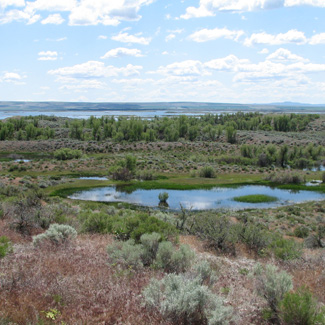North Potholes Reservoir
The Site
North Potholes Reservoir is a unique blend of riparian habitats, freshwater ponds and marshes, large tracts of open lake, and arid shrub-steppe. Also known as North Potholes Wildlife Area and South Columbia Basin Wildlife Area, it is a birder's paradise. Located near the center of the Columbia Plateau ecoregion, North Potholes Reservoir includes the North Potholes Reserve and falls within the Desert Wildlife Management Area. The area is dependent upon the fluctuating levels of Potholes Reservoir to maintain riparian and freshwater pond/marsh habitat. Riparian habitat is dominated by thick water willow interspaced with larger peach-leafed willow. Shrub-steppe flora include typical Eastern Washington species.
The Birds
The North Potholes Reservoir contains one of the largest rookeries of Great Blue Herons and Great Egrets in the state. In late summer and early fall, it is one of the largest staging areas for American White Pelicans in the state. Winter brings large numbers of Bald Eagles, which use the area as a nighttime roost. North Potholes Reservoir hosts one of the only known communities of Bushtit (interior race). Gulls and terns nest on the exposed tops of sand dunes that begin where Potholes Reservoir meets the sand dunes (accessible by boat only). Large numbers of Western and Clark's Grebes nest in the backwaters of the reservoir. Migrants include aforementioned American White Pelicans, Bald eagles, and a good variety of shorebirds and passerines.
Directions and Suggestions
Late spring through early fall are prime times to visit this area. Access in winter can be difficult.
Take exit #174 from I-90 (Mae Valley/Hansen Road) and turn south to South Frontage Road. Turn west on South Frontage Road and go approximately 2.3 miles. Turn left on the gravel access road. All roads lead to good birding. You may wish to explore - by taking different roads you can reach different birds. North Potholes Reserve and the rookeries require you to stay on the right-hand track. (The Bushtits are located here as well.) Following the left track will take you to Western and Clark's Grebe congregations. American White Pelicans can be observed from either location. A Washington Department of Fish and Wildlife Vehicle Use Permit is required in this area when access is via roadways. The area can also be reached by boat from Potholes Reservoir. However, once inside the sand dune area, it can be very confusing; several boaters get lost each year and need to call for assistance to find their way back out. Caution and a GPS device are recommended.
There are few amenities in the area and birding is primitive. Spring brings good numbers of ticks and biting insects. Walking can be very productive, but the terrain can be confusing so caution is advised.
Rookeries are very sensitive to intrusion. Please stay out of the rookery areas during nesting season. (There is an effort under way to close foot access to these areas in the future.)

